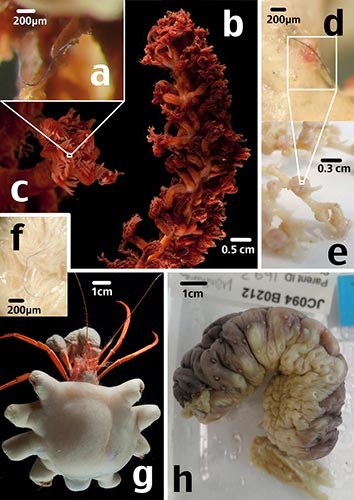Deep-Sea Organisms Are Affected by Plastics Too
Plastics are contaminating almost every ecosystem in this world. Following the findings of plastics around Antarctica, experiments from a study now have confirmed that microplastics are transferred into deep-sea organisms through their feeding methods.
The contamination of macro-plastics is already alarmingly prevalent and can be found affecting marine lives in large scale. You could’ve seen the disturbing pictures of seabirds and turtles that are stuck with plastic, and even some horrible images of plastics ingested by them. This study has now shown the public how microplastics have affected aquatic life in the deep realm of oceans (334–1783 m deep in the equatorial mid-Atlantic, 954–1062 m in the south-west Indian Ocean), which were once assumed as one of the unpolluted regions in the world.

Organisms found to have ingested microfibers. Image by M. L. Taylor | CC BY
Dissections also have shown that most of these organisms have a trace amount of microfibers both internally and externally. According to these researchers, without enough experiments, the long-term ecological impact of microplastics on the marine life cannot be studied in-depth.
But it appears that there is a scarier possibility for biomagnification here. Though only trace amounts of microplastics have found its way to the deep oceans, still it is something to worth note that the source of this contamination is our ecosystem.
This post was first published on October 1, 2016.











According to these researchers, without enough experiments, the long-term ecological impact of microplastics on the marine life cannot be studied in-depth.’ – I do not understand this…. Why would one do more research on the effect of microplastics? It is clearly known that plastic is poison and it should not be in the ocean… The long-term ecological impact is destruction.. Simple.. Why would one need more experiments to understand the in-depth impacts? That’s hilarious!!! It is poison and it should be stopped. Simple…. The microplastics have not reached the depth is because, they are light, and their specific gravity is less than that of the brine and hence will not sink easily. So, it has not reached… I think, the researchers do not need to wait until the microplastics reached the bottom of the ocean, then, conduct experiments to say, “Yes, it is destructive, and it kills marine life or alters the DNA”… In this matter, I think, it is better Prevention than, “Research and Cure”.. 🙂 We have to stop it.. Simple…
True. Plastic is something that shouldn’t be in the ocean. But it is essential to understand how plastics will affect the lives in such ecosystem. Understanding that would help us find solutions from other angles too. What if something shows signs of evolution to disintegrate plastics? Like the bacteria that assimilates PET. It’s worth keeping a tab on them to know more.
Still, the impact of plastic is destruction, and “it is not easy to understand the impact” is hilarious… May be if they say, “we want to know how the organisms behave on the microplastics”, then, what you mentioned as “What if something shows signs of evolution to disintegrate plastics?” would have some answers. I would safely assume that “plastics; micro or macro, has no place in oceans (land and air too!!). Even, if the researchers find that certain compounds of plastics are safe in oceans, etc., it is not a good idea. Individually, some compounds might be non-toxic, but, when they are in a mixture with 100s of many chemicals and compounds, they might not be safe as claimed. They are certainly not safe. My point is that why would they wait more to conduct experiments, eventually to say “they are toxic”. Letting plastic into oceans means destruction. I think, it is as simple as that, and researchers should shout warnings whatever the case may be. The research can be conducted, may be in a controlled environment in labs etc to understand “in-depth” analysis..
Love this! 🙂 And about the experiments, I think these experiments are just proving that plastics have reached deep sea. There are tons of observations in a larger scale that had already proved “plastics are environmental hazard”. However, this particular team might be looking for more traces in other organisms to obtain some solid proof. Policy makers don’t do that good with assumptions and weak data. We all know that it’s toxic, but those people in the governments have a history of ignoring these alarms.
All the more, microplastics (for example in toothpaste and shampoos) are unnecessary. There are quite fantastic natural ingredients available, that are even superior, environment friendly and more effective than microplastics, which can do the job a lot better!!! 🙂 🙂 🙂